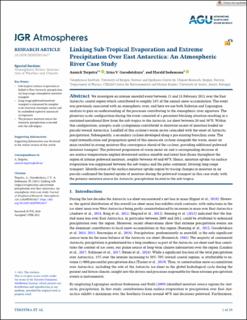| dc.contributor.author | Terpstra, Annick | |
| dc.contributor.author | Gorodetskaya, Irina V. | |
| dc.contributor.author | Sodemann, Harald | |
| dc.date.accessioned | 2022-03-30T13:28:36Z | |
| dc.date.available | 2022-03-30T13:28:36Z | |
| dc.date.created | 2022-01-18T17:53:56Z | |
| dc.date.issued | 2021 | |
| dc.identifier.issn | 2169-897X | |
| dc.identifier.uri | https://hdl.handle.net/11250/2988641 | |
| dc.description.abstract | We investigate an intense snowfall event between 15 and 18 February 2011 over the East Antarctic coastal region which contributed to roughly 24% of the annual snow accumulation. The event was previously associated with an atmospheric river, and here we use both Eulerian and Lagrangian analysis to gain an understanding of the processes contributing to the atmospheric river signature. The planetary-scale configuration during the event consisted of a persistent blocking situation resulting in a sustained meridional flow from the sub-tropics to the Antarctic ice sheet between 20 and 50°E. Within this configuration, synoptic-scale cyclogenesis contributed to slantwise ascent of moisture loaded air parcels toward Antarctica. Landfall of this cyclone’s warm sector coincided with the onset of Antarctic precipitation. Subsequently, a secondary cyclone developed along a pre-existing baroclinic zone. The rapid intensification and propagation speed of this mesoscale cyclone alongside the warm, moist air mass resulted in strong moisture flux convergence ahead of the cyclone, providing additional poleward moisture transport. The poleward progression of warm moist air and a corresponding decrease of sea-surface temperatures implied downward surface sensible and latent heat fluxes throughout the region of intense poleward moisture, roughly between 40 and 60°S. Hence, moisture uptake via surface evaporation was suppressed between the sub-tropics and the polar continent, favoring long-range transport. Identification of the surface moisture uptake region by tracing changes in moisture in air parcels confirmed the limited uptake of moisture during the poleward transport in this case study, with the primary moisture source for Antarctic precipitation located in the sub-tropics. | en_US |
| dc.language.iso | eng | en_US |
| dc.publisher | Wiley | en_US |
| dc.rights | Navngivelse 4.0 Internasjonal | * |
| dc.rights.uri | http://creativecommons.org/licenses/by/4.0/deed.no | * |
| dc.title | Linking Sub-Tropical Evaporation and Extreme Precipitation Over East Antarctica: An Atmospheric River Case Study | en_US |
| dc.type | Journal article | en_US |
| dc.type | Peer reviewed | en_US |
| dc.description.version | publishedVersion | en_US |
| dc.rights.holder | Copyright 2021. The Authors | en_US |
| dc.source.articlenumber | e2020JD033617 | en_US |
| cristin.ispublished | true | |
| cristin.fulltext | original | |
| cristin.qualitycode | 2 | |
| dc.identifier.doi | 10.1029/2020JD033617 | |
| dc.identifier.cristin | 1984044 | |
| dc.source.journal | Journal of Geophysical Research (JGR): Atmospheres | en_US |
| dc.relation.project | Norges forskningsråd: 262710 | en_US |
| dc.identifier.citation | Journal of Geophysical Research: Atmospheres. 2021, 126 (9), e2020JD033617. | en_US |
| dc.source.volume | 126 | en_US |
| dc.source.issue | 9 | en_US |

